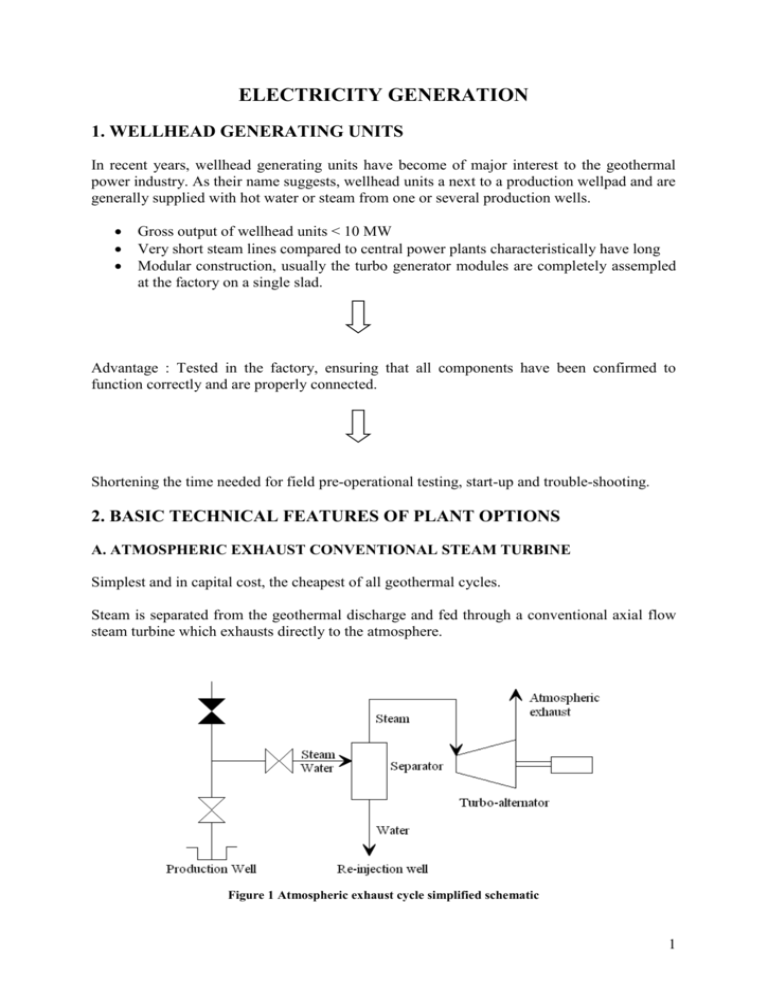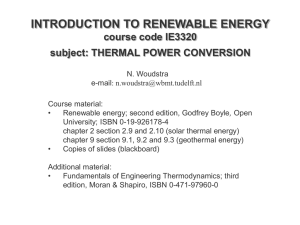ELECTRICITY GENERATION
advertisement

ELECTRICITY GENERATION 1. WELLHEAD GENERATING UNITS In recent years, wellhead generating units have become of major interest to the geothermal power industry. As their name suggests, wellhead units a next to a production wellpad and are generally supplied with hot water or steam from one or several production wells. Gross output of wellhead units < 10 MW Very short steam lines compared to central power plants characteristically have long Modular construction, usually the turbo generator modules are completely assempled at the factory on a single slad. Advantage : Tested in the factory, ensuring that all components have been confirmed to function correctly and are properly connected. Shortening the time needed for field pre-operational testing, start-up and trouble-shooting. 2. BASIC TECHNICAL FEATURES OF PLANT OPTIONS A. ATMOSPHERIC EXHAUST CONVENTIONAL STEAM TURBINE Simplest and in capital cost, the cheapest of all geothermal cycles. Steam is separated from the geothermal discharge and fed through a conventional axial flow steam turbine which exhausts directly to the atmosphere. Figure 1 Atmospheric exhaust cycle simplified schematic 1 For the same inlet pressure; Consume about twice as much steam as condensing plants per KW of output, Wasteful of energy and costly in wells. Can be used as pilot plants. Can be used for small local supplies from isolated wells Can be used for electricity generation from the discharge of test wells during field development. The altitude that the unit is operated at has an important effect on the power that is produced from a given inlet pressure and steam mass flow. At higher altitudes the lower exhaust pressure, corresponding to the lower atmospheric pressure, results in great power generation. Example: Okanio field in kenya is 1950 m above sea level. The atmospheric pressure is 0.8 bara. Steam mass flow rate is increases by 10.5 % for a typical inlet pressure of 8 bara. B. CONDENSING EXHAUST CONVENTIONAL STEAM TURBINE It is thermadynamic improvement on the atmospheric exhaust design. Instead of discharging the steam from the turbine to the atmosphere it is discharged to a condensing chamber that is maintained at a very low absolute pressure- typically about 0.12 bara. Because of the greater pressure drop across a condensing turbine approximatelly twices as much power is generated compared to atmospheric exhaust. The reason the exhaust steam must be condensed is that an impractical amount of work would be required to pump the fluid from the low-pressure conditions in the condenser unless it is first converted to the liquid state. However, the addition of a condenser and the associated cooling towers and pumping equipment significantly increases the cost of the total plant. In addition, the non-condensable gases that are also present in geothermal steam, and which accumulate in the condenser, must be separately pumped from the condenser using gas extraction equipment. 2 Figure 2 Condensing cycle simplified schematic C. BINARY PLANT Geothermal binary fluid technology has been developed primarily to generate electricity from low-to-medium-temperature resources and to increase the utilization of thermal resources by recovering waste heat. An obvious source of waste heat in geothermal fields is the separated water from the flash separators. The binary system utilizes a secondary working fluid, which has a low boiling point and high vapour pressure at low temperatures when compared to steam. This secondary fluid is operated through a conventional Rankine cycle. By selecting the appropriate working fluid, binary systems can be designed to operate with inlet temperatures in the range 85-170 0C. The upper temperature limit is restricted by the thermal stability of the organic binary fluids. The lower temperature limit is primarily restricted by practical and economic considerations as the required heat exchanger size for a given capacity becomes impractical. Heat is transfered from the geothermal fluid to the binary cycle via heat exchangers where the binary fluid (or working fluid) is heated and vaporized before being expanded through a turbine to some lower pressure/temperature. 3 Figure 3 Binary cycle simplified schematic 3. THERMODYNAMICS OF CYCLES A. Thermodynamics of Flash Process The flashed steam process is both extremely simple and efficient. A temperature-entropy diagram for a typical flash process is shown below, where the reservoir fluid has been taken as all liquid at 281 0C with a corresponding enthalpy of 1241 kJ/kg. (Figure 4) Figure 4 Temperaturee entropy diagram of typical geothermal flashed steam process and available isentropic heat drop 4 Isenthalpic expansion as the fluid flashes during its passage up the well to the optimized separation pressure of 7 bara. The separated steam is then passed through a condensing turbine with a condenser pressure of 0.12 bara. Isentropic heat drog from various points along this process relative to the condensing temperature of 50 0C. The isentropic process represents the theorelical maximum power extracted by a heat engine between an initial and final temperature. 1. The maximum power that could be produced using the reservoir fluid at reservoir conditions (Requirement of downhole pumps) Mass (1241-975) = 266 * mass kW, 100% 2. Total flow from optimized separator condition Mass (1241-1031) = 210 * mass kW, 79% 3. Optimized separated steam flow through condensing turbine. 0.263 Mass (2764-2146) = 163 * Mass kW, 61 % This example illustrates the following generalization regarding the flash process. The exact proportions of the relationships are dependent on the enthalpy of the fluid. 1. It is necessary to waste typically 20 % of the available heat drop of the reservoir fluid due to the need to drop the fluid pressure to achieve natural well flow at reasonable flow rates. 2. Of the total fluid in the separator most of the available heat drop is contained in the steam flow and with this example only 21% is lost with the separated water. B. THERMODYNAMICS OF ORGANIC RANKINE CYCLE The use of an organic fluid with the low temperature Rankine cycle has many advantages over using water. However, it should be noted that the Rankine cycle efficiency for the organic fluids used is little different to that for water / steam between the same two top and bottom cycle temperatures. In fact, the cycle efficiency is often slightly less for the organic fluid. The thermodynamic attraction of an organic fluid is that it is able to extract more heat from the geothermal hot source than water. This is primarily a consequence of the organic fluid having a far lower ratio of latent heat of vaporization (at these lower boiling temperatures) versus specific heat capacity than water. As a consequence, even though the cycle efficiency is about the same value in the two cases, the overall efficiency, which is proportional to the generated electrical energy, is considerably higher for the organic fluid. The overall efficiency is, by definition, the cycle efficiency times the ratio of thermal power extracted to thermal power available from the hot source. The available thermal power is computed using an arbitrary minimum temperature 10 0C higher than the bottom temperature of the cycle. The above points are illustrated in Figure 5, which shows temperature – entropy diagrams for two Rankine cycles operating between 105 and 40 0C using R114 (dichlorotetrafluorethane, CClF2 – CClF2 in one case and water in the other) The following processes are involved in the Rankine cycle as labelled in Figure 5: 5 a-b: Pressure increase by feedpump b-c: Heating at constant pressure to dry vapor state c-d: Isentropic expansion through turbine d-a: Condensing the latent heat of vaporization and specific heat capacity for the two fluids at the appropriate temperatures is: (a) Latent heat of vaporization at 105 o C(kJ/kg) (b) Average specific heat capacity over range 40-105 o C(kJ/kg) (c) Ratio of (a) to (b) (K) R144 Water / Steam 86.6 2244 1.12 4.17 77 538 Figure 6 shows a temperature versus thermal power graph for the geothermal fluid heat source and R114 or water / steam working fluid. Geothermal brine line: For a given mass flow of geothermal fluid, the thermal power transfer with change in temperature is fixed at constant pressure conditions. For the geothermal fluid shown in Figure 6, a thermal power of 5900 kW (kJ/s) is transferred with a temperature drop of 49.5 0C (140-90.5 o C interval). The enthalpy change in these conditions is 212 kJ / kg from steam tables. Figure 5 Characteristics of organic Rankine cycle using R114N comparison with equvalent Rankine cycle using water 6 Figure 6 Temperature-thermal power diagram for heat exchange using water or R114 as secondary fluid Working fluids: Consider that working fluids are boiling at constant pressure and 105 o C. Available thermal power for boiling can be calculated at a temperature of 115 higher than boiling temperature). o C (10 o C 3200kj / s 37.0kg / s 86.6kj / kg 3200kj / s Massflowra te( water / steam) 1.43kg / s 2244kj / kg Massflowra te( R114) It is now possible to determine the additional heat that is required to raise the working fluid temperature from 40 to 105 o C. For R114 => M*C*ΔT = 37*1.12* (105-40) = 2694 kj/s For water / steam => M*C*ΔT = 1.43*4.17* (105-40) = 388 kj/s Total thermal powers transfered; R114 => 3200 + 2694 = 5894 kW => 90.5 o C at geothermal fluid Water / steam => 3200 + 388 = 3588 kW => 110 o C at geothermal fluid 7






